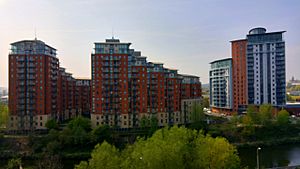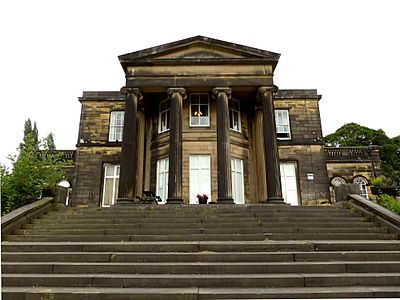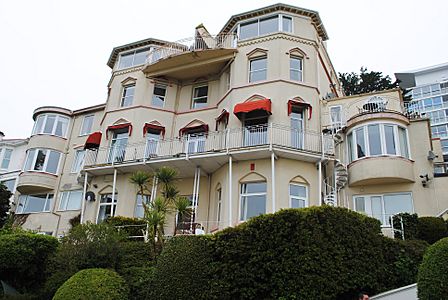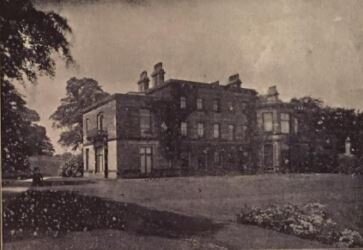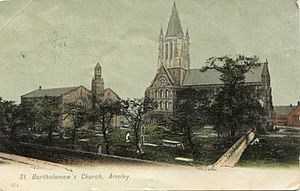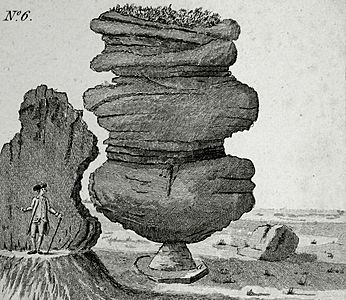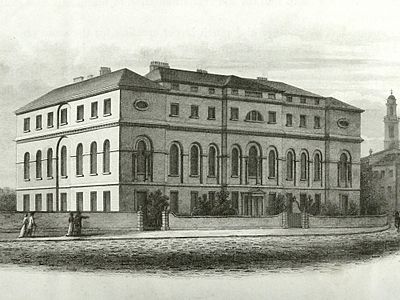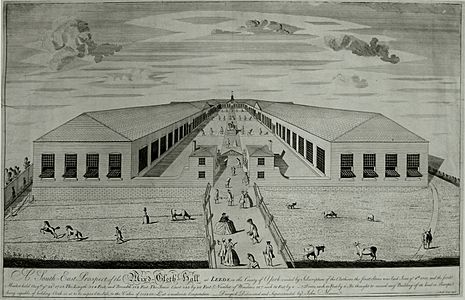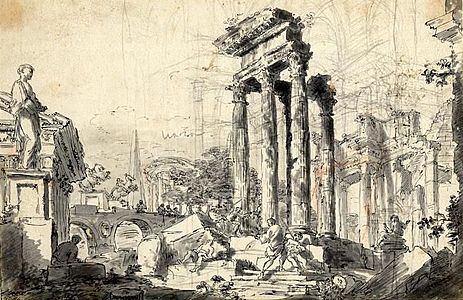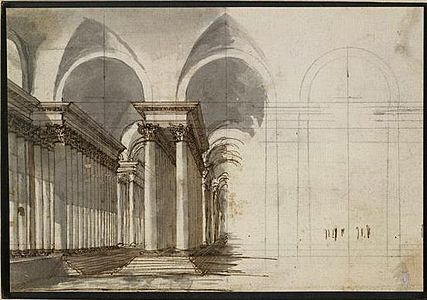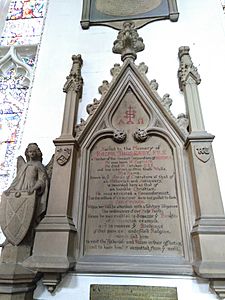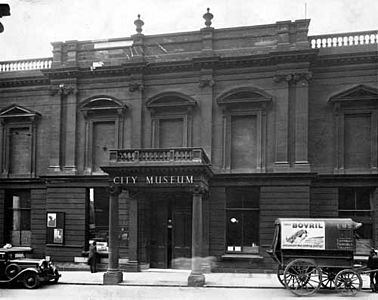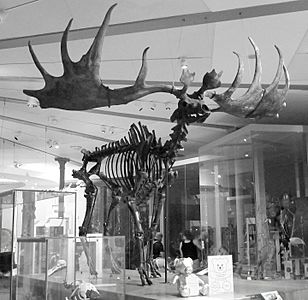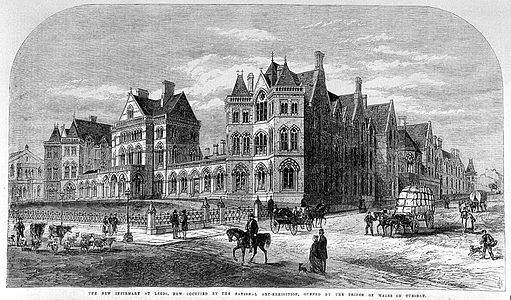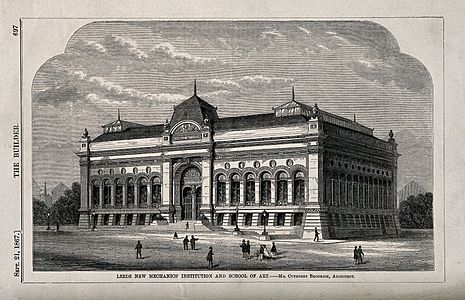William Gott (industrialist) facts for kids
Quick facts for kids
William Gott
|
|
|---|---|
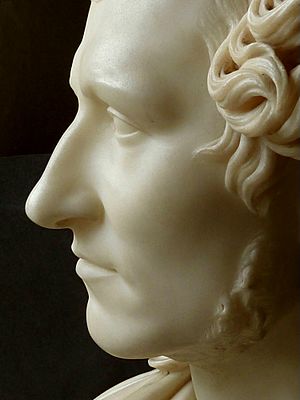
Bust of William Gott by Joseph Gott, 1834
|
|
| Born | 1797 Leeds, West Riding of Yorkshire, England
|
| Died | 25 August 1863, aged 66 |
| Nationality | English |
| Occupation | Wool merchant, mill-owner |
| Known for | Philanthropy towards public services, collecting fine art and rare books, supporting building of Leeds General Infirmary (1863), paying low wages which caused a weaver's strike |
| Parent(s) |
|
William Gott (born in Leeds in 1797, died in Patterdale on August 26, 1863) was an important wool merchant and factory owner from Leeds, England. He was also a philanthropist, meaning he gave money and time to help public services. William Gott was also a well-known art collector.
He and his brother John took over their father Benjamin Gott's businesses, including Armley Mills and Park Mills in Leeds, in the 1820s. Their company, Gott & Sons, was a very large employer in the area. They had hundreds of regular workers and many weavers who were paid for each piece of work they finished. The company faced legal action because of smoke pollution from their factories. They also had a difficult time during a weavers' strike, where workers stopped working because of low pay.
William Gott lived in several large homes, including Denison Hall and Wyther Hall in Leeds, and Bay Fort in Torquay. He was married twice and had at least six children. One of his sons, John Gott, later became a bishop. William Gott gave money to churches and public buildings. He also donated items, like the famous Leeds Tiger, to the Leeds Museum. His art collections are now spread out, but some of his books of watercolours, lithographs, and drawings are kept at the Hepworth Gallery in Wakefield. His drawings by the artist Giovanni Battista Piranesi are in the British Museum.
Contents
William Gott's Early Life and Family
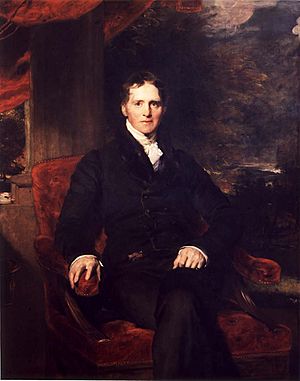
William Gott's grandparents were John Gott, an engineer, and Susanna Jackson. His parents were Benjamin Gott (1762–1840) and Elizabeth Rhodes (1768–1857). William was their third son, born in Leeds in 1797. He had three brothers, John, Benjamin, and Henry, and a sister named Harriet. William went to a drawing school in Leeds run by Joseph Rhodes.
His First Marriage
On August 15, 1821, William Gott married Margaret Ewart (1795–1844) in Childwall. Margaret's brothers were important figures, including William Ewart, who was a Member of Parliament. William and Margaret had at least six children. All of their children were born in Leeds. Their children included Margaret, William Ewart Gott, Elizabeth, Anne, and John Gott. John Gott later became a vicar in Leeds and then the Bishop of Truro. Their youngest daughter was Harriet Caroline.
His Second Marriage
After Margaret passed away, William Gott married Susannah Maria McLauchlan Raoux (1822–1901) on July 28, 1851. She was a widow from Paris. William was 25 years older than her, and they did not have any children together. After William Gott died, Susannah married a third time to Archdeacon Anthony Huxtable.
Other Events in His Life
In 1829, William Gott's children's teacher, Miss Daniel, was tricked into marrying a man named Joseph Stanley. Stanley was already married and had many children. He had pretended to be in debt to his first wife and taken all her money. William Gott and his family tried to help Miss Daniel. The first Mrs. Stanley pressed charges, and Joseph Stanley ran away.
In 1832, a new road was built on land owned by Gott & Sons in Leeds. It was named Gott's Road. This road helped improve travel in the area.
His Beliefs and Character
People who knew William Gott described him as a kind and fair person. Even though he was a strong supporter of the Conservative political party, he respected other people's political views. He was also a dedicated member of the Church of England and worked to help the church.
One person said that Gott was "upright and just in every relation of life." They also mentioned his kindness, sympathy for those in sorrow, and his desire to make others happy. He was known for being generous with his charity. Although some thought he didn't take part in public life, he was a councillor for Leeds Corporation.
Where William Gott Lived
From at least 1830 to 1851, Gott lived in Denison Hall in Leeds. This large 18th-century house is now a Grade II* listed building. Later in his life, he lived at Wyther Grange (also called Wyther Hall) in Leeds and Bay Fort in Torquay.
-
Bay Fort, Torquay (now apartments)
His Death and Funeral
William Gott had not been in good health for some years. He died suddenly on August 25, 1863, while visiting Patterdale, Northumberland. He caught a cold and became very ill.
His funeral was held on September 1, 1863, at the former St Bartholomew's Church, Armley. He was buried in the family tomb. Many people attended the funeral, and shops in Leeds closed as a sign of respect. The bells of the Town Hall and other churches rang slowly. William Gott left a large amount of money in his will, showing his success as a businessman.
William Gott's Business Career

William Gott and his brother John were senior partners in Benjamin Gott & Sons. This company made and sold woollen cloth at Armley Mills and Park Mills in Leeds. They took over from their father in 1825. By 1861, the brothers employed a total of 291 men, 361 women, 63 boys, and 102 girls.
Smoke Pollution Trial in 1824
In 1824, Benjamin Gott and his sons, John and William, faced legal charges. The charges were about the smoke coming from their Park Mills at Bean Ings. This mill was one of the first large steam-powered wool mills in the world. The case was very important to factory owners and engineers. It showed the conflict between the benefits of industry and its dangers.
People living near the mill complained that their gardens were covered in soot. They also said that they couldn't wash and dry their clothes outside. The court discussed how much Gott & Sons should pay, as they had already tried to reduce the smoke.
Weavers' Strike in 1831
In 1826, Gott & Sons lowered their weavers' wages by 15%. They promised to raise wages when business improved. In January 1831, the weavers asked for their wages to be increased. After waiting two weeks, they sent a group to meet with William Gott and his manager. The company refused to raise wages.
Because of this, several hundred weavers went on strike on February 15, 1831. They finished their current work and handed it in to avoid being accused of stealing. Gott & Sons then fired all the women and children who worked with the striking weavers. It was found that Gott & Sons were paying lower wages than other wool mills nearby.
Business Challenges
In 1841, Gott was a director of the Leeds and Selby Railway Company. This was an important role in the growing railway industry.
In 1842, the Leeds Town Council met to discuss problems faced by local manufacturers. Many businesses were going bankrupt, and workers were becoming poor. This was due to the Corn Laws, which made trade difficult for Britain. Gott & Son sent a letter saying they had lost large orders to France and Belgium. They had to close their Armley Mills works because of the loss of trade. It was estimated that local wool workers had lost a lot of money in wages due to these laws.
The Gott Collection of Art and Books
William Gott built a wonderful collection of rare books. Sadly, these books were later sold and spread out. His son John inherited the library, which was sold between 1908 and 1910.
The Leeds Intelligencer newspaper said that William Gott loved fine arts. Collecting art was his main hobby at home. He enjoyed being surrounded by beautiful objects he had collected since he was a boy. He was also a member and vice-president of the Leeds Philosophical and Literary Society. He often helped the society by donating items.
One painting in Gott's collection was Landscape with Cattle by Annibale Carracci. It was shown in Leeds in 1830. A part of Gott's collection that still exists is at the Hepworth Gallery in Wakefield. It includes over 1,200 watercolours, drawings, and prints. These artworks show more than 200 towns and villages in Yorkshire. The Hepworth Gallery has made the Gott Collection available online.
- Artworks from the Gott Collection at The Hepworth
-
Drawing of Brimham Rocks, by James Basire after Hayman Rooke, 1780s
-
Former Leeds General Infirmary building, by John Le Keux, after Thomas Taylor, early 19th century
-
Former Moot Hall in Briggate, by Charles Haith after Thomas Taylor, 1816
Another part of Gott's collection, including at least 55 drawings by Giovanni Battista Piranesi and other artists, is now at the British Museum.
- Sketches from the Gott Collection in the British Museum
-
Piranesi, 1742–1743
William Gott's distant cousin, Joseph Gott, who was a sculptor, made a marble statue of William Gott in 1834. This statue was shown at the Leeds Art Gallery in 2011.
In 1862, William Gott showed many items from his collections at an event for the Leeds Philosophical Society. These items showed his wide range of interests.
Early Manuscripts and Books
- Bible from the 11th century, with beautiful drawings.
- Psalterium (a book of psalms) from 1165, from Flanders, with its original binding and a chain.
- Missal (a book for church services) from about 1430, with many bright drawings.
- A Persian manuscript with many detailed miniature drawings.
- The Koran in Persian and Arabic, with gold borders.
- A Manuscript from Sri Lanka written on a palm leaf.
Important English Books
- Myles Coverdale's Bible, the first full Bible translated into English, from 1535.
- Tyndale's Testament, from 1536.
- The first Church of England prayer-book, from 1549.
- First collected edition of Shakespeare's works, from 1623.
- Early copies of some of Shakespeare's plays, like Romeo and Juliet (1599) and Hamlet (1611).
- Milton's Paradise Lost, first edition, from 1667.
- Izaak Walton's Angler, first edition, from 1653, with the author's signature.
- A long letter from Ralph Thoresby, who wrote a history of Leeds.
- A letter from John Harrison, who built and supported important buildings in Leeds.
Early Printed Works
- Biblia pauperum, an early book printed using woodblocks, before movable type, from about 1430.
- Golden Legend, printed by William Caxton, the first English printer, in 1483.
- Dives et Pauper, printed by Wynkyn de Worde, the second English printer, in 1496.
- A complete set of the newspapers where the story of Robinson Crusoe first appeared in 1719.
Oil Paintings
- Burns' Cotters' Saturday Night, by C. Cope.
- Keeping the Birthday of James Hogg, the Ettrick Shepherd, by Sir William Allan. This painting shows famous people like Sir Walter Scott.
- The Last Judgment (the side of the blessed), a copy by Vincenzo della Brema of a painting by Fra Angelico.
Other Interesting Items
- Many watercolours and other paintings.
- Three large and beautiful bronze vases from the Summer Palace in Pekin, showing early Chinese art.
- A pair of Japanese vases and other interesting items from China and Japan.
- Several items bought from the 1862 International Exhibition.
William Gott's Philanthropy
William Gott was a generous person who gave a lot to charities in Leeds. He did good deeds quietly, without showing off. He loved his hometown and wanted to see it grow and improve. The Leeds Intelligencer newspaper said he was "a man of generous spirit."
Around 1841, Gott paid for the Thoresby monument in Leeds Parish Church. In 1845, he helped the Leeds Dispensary. In the same year, he paid to replace rented pews with free pews in St Paul's Church in Leeds, so everyone could sit for free.
In 1863, William and his brother John each gave £1,000 to help build the Leeds Infirmary, a hospital. They also gave £500 in 1862 to expand the Leeds Philosophical Hall. In 1865, they helped build the Leeds Mechanics Institute. The Leeds Intelligencer also reported that William Gott supported the people who worked in his factories. He worked to make their lives more comfortable. He even suggested a plan to create allotment gardens for mill workers.
Gott was a very generous supporter of the Leeds Philosophical and Literary Society. He was one of its vice presidents. In 1862, he gave the society a "beautiful collection of manuscripts." He also donated a taxidermy-mounted Bengal tiger, now known as the Leeds Tiger, and a large fossil of the great Irish elk to the society.
One person said that Gott was known for his kindness to those in need, especially his own workers. He helped promote the social, moral, and religious improvement of the working classes. He was always at the forefront of helping any public project and wanted to make Leeds a great city.
The Western Times newspaper also said that Gott was a "liberal supporter" of local charities in Torquay, where he lived later in life.
Projects Funded by William Gott
-
Ralph Thoresby monument, Leeds Minster, 1841
-
Former St Paul's church pews, Park Square, Leeds, 1845
-
Extension to the Philosophical Hall (former Leeds Museum, Park Row), 1862
-
Leeds Irish Elk, 1862
-
Leeds Infirmary, 1863



